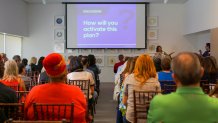When the Dallas City Council unanimously approved a new Cultural Plan, created by City of Dallas Office of Cultural Affairs (OCA), on Nov. 28, the vote was the culmination of a one-year process to strengthen Dallas’ growing arts ecology.
“A unanimous vote of support from City Council to formally adopt the plan was tremendous – it clearly shows the strong and broad support for the plan, and given that mayoral and City Council elections are coming up in the spring, this unanimous vote is a signal that this plan will have support to expand the arts citywide and allow us to address the priorities in the plan,” Jennifer Scripps, the director of the OCA, said.
The OCA’s previous cultural plan was adopted 16 years ago, long before the Dallas Arts District was complete, Klyde Warren Park was built, and social media was invented.
Recognizing the Dallas’ changing cultural needs, the OCA facilitated a conversation with Dallas citizens about how to modernize the plan. Nearly 9,000 Dallas residents participated in more than 150 public, committee and taskforce meetings.
Among those participants were artists and arts leaders.
“It was so joyful to see these people so passionate they physically showed up. That was exciting,” Kevin Moriarty, Dallas Theater Center’s artistic director said. “It was so cool that the plan is so representative of what people feel Dallas needs artistically,” Katie Cooper, Avant Chamber Ballet’s artistic director, said.
The Cultural Plan boils down Dallas citizens’ needs into six priorities: equity, diversity, space, support for artists, a sustainable arts ecosystem and communication. Equity is the Cultural Plan’s top priority with the other five priorities supporting the concept of equity. The plan defines equity as supporting “the broadest range of art forms and creative producers, considering inclusivity, diversity and neighborhood impact to direct resources equitably to artists and organizations.”

For the OCA, that priority creates a new mandate for funding established, venerated institutions and smaller and emerging arts organizations.
The Scene
“We’re looking really hard at how those bigger organizations do their work: their hiring practices, their board leadership, the product and how their product truly reflects and speaks to the entire population of Dallas,” Scripps said.
Scripps applauds the Dallas Theater Center for their Public Works Dallas program, an initiative designed to engage the community through theater-making.
“Our mission is to make theater for and of and with our community. At every level of the theater, we need to be a theater that represents the community.” Moriarty said, explaining theater is the ideal venue for a community to explore its history, fears and prejudices. “We have a special obligation to serve as a communal gathering place for Dallas.”
Smaller arts organizations view equity as an opportunity to expand their reach. “I think you’re going to see more and more emphasis on groups that are diverse and that are doing work in geographic areas that are underserved,” Scripps said.
Sam Brukhman, Verdigris Ensemble’s artistic director, finds inspiration in the Cultural Plan as he works on the choir’s Faces of Dallas project.
“It’s been really cool to see the Office of Cultural Affairs really pushing on equity and creating avenues for different cultures and it has really pushed me to think outside the box on how Verdigris Ensemble fits into that and how we continue to be relevant and inclusive.”

Reaching out to diverse neighborhoods could also help solve the arts community’s most common problem: space. While Scripps points out that the city is reevaluating the management of 20 city-owned cultural facilities, Cooper envisions growing her season by performing outside the ballet company’s usual performance space, Moody Performance Hall in the Dallas Arts District.
“We can be at Moody, but everyone wants to be at Moody. It’s like we need two of them,” Cooper said. “If we had more options in other areas of Dallas, we could have more performances.”
The Cultural Plan explains the growth of Dallas’ creative economy lags the city’s economic growth by 22 percent. That lag is more than seven times than that of Houston. Artists, looking to make a living wage creating art, leave North Texas.
“We cannot be exporting out talent like we have been,” Scripps said. “We train them at the highest level of excellence and expertise and then they go off to the coasts.”
Brukhman, New Jersey native, noticed a disheartening difference for singers in Dallas: they are paid about two-thirds of what their counterparts in New Jersey earn.
“As Verdigris Ensemble grows, I am trying to give my singers the best possible rates I can. I think the Cultural Plan has really shown that there is a possibility to grow,” he said.
Supporting the pipeline for developing artists is critical.
“I can’t hire dancers that don’t exist, so we need to be training kids of color and creating a culture where they feel welcome, where they feel valued,” Cooper said. “As we pay our artists closer to living wage, people won’t move away. They’ll be able to stay in Dallas.”

The Cultural Plan is an ambitious blueprint intended to shape the arts community for the next seven to 10 years. Scripps plans to update the Arts and Culture Advisory Commission on a quarterly basis with annual goal posts to measure progress. The city’s commitment to the Plan impresses Moriarty.
“It’s a big moment in Dallas when the leaders agree that the arts are an essential part of our life and should be in every neighborhood,” he said.



